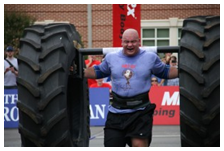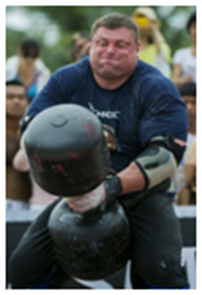Now let’s take a look at some real life examples of how athletes who train on a diet according to their specific nutritional needs stack up against those who don’t in strength and power sports. It’s always difficult comparing athletes and attributing their differences to only one element, such as diet. There are numerous other factors that can influence an athlete’s performance compared to others, many of which can’t be quantified. For example, psyche, experience, training routine, body size/height, muscle fibre type, and many other factors all play a significant role in an athlete’s performance. For the purpose of showing how diet alone can make a difference in the performance of strength athletes, all comparisons will be attempted to be made between athletes of as similar physique, training, and experience as possible.
3.1 Strongman Mike Jenkins
Let’s take a look at how professional strongman competitor Mike Jenkins incorporates diet into his training in order to dominate his competition. Jenkins is a prime example of a true power and strength athlete. He is a 400-pound athlete who is one of the best in his sport, which “requires you to be able to deadlift 500 pounds for several reps, pull a tractor trailer hundreds of yards, and then carry hundreds of pounds in each hand as you walk 100 yards, in sand.” He is also a follower of the paleo diet. (http://www.stayfitcentral.com/paleo-diet-2/20-paleo-elite-professional-athletes-learn-their-secrets-to-success/)

(http://www.stayfitcentral.com/wp-content/uploads/2013/09/mike_jenkins-300×199.jpg)
But what exactly is the paleo diet, and how does it work well with Jenkins’ needs as a power athlete? As defined by Google, it is “a diet based on the types of foods presumed to have been eaten by early humans, consisting chiefly of meat, fish, vegetables, and fruit, and excluding dairy or grain products and processed food.”(https://www.google.ca/webhp?sourceid=chrome-instant&ion=1&espv=2&es_th=1&ie=UTF-8#q=define+paleo+diet) This diet focuses on reducing carb intake and shifting your body to rely more on fat-stored energy. It also provides lots of protein needed for muscle hypertrophy through the consumption of many lean meats, which is really important for power athletes trying to build mass and strength. (http://robbwolf.com/what-is-the-paleo-diet/) The healthy polyunsaturated and monounsaturated fats from sources like avocados, almonds, and olive oils provide enough energy to fuel an athlete through a workout. This relatively lower carb/higher fat based diet has also been found to help regulate and boost hormones such as insulin and testosterone needed for building muscle, whereas a higher carb/lower fat based diet can disturb the balance of these hormones leading to a chronically inflamed body and fatigue which will interfere with the intense training of a pro strength athlete. (http://www.stayfitcentral.com/paleo-diet-2/20-paleo-elite-professional-athletes-learn-their-secrets-to-success/)
Jenkins does use some slight alterations to the standard paleo diet to better customize it to his specific training needs as a strongman competitor. For example, he will add some cottage cheese to a beef and egg based paleo protein shake after his workouts to better aid in muscle repair and growth. He will also consume a lot more carbohydrates than other followers of the paleo diet in order to help fuel his very demanding workouts. Jenkins will often eat up to four thousand calories a day, which sounds high but is quite reasonable considering how big he is and how he trains hard several days a week. (http://www.stayfitcentral.com/paleo-diet-2/20-paleo-elite-professional-athletes-learn-their-secrets-to-success/)
3.2 Jenkins versus the Competition
Now let’s take a look at who we will be putting Jenkins up against: Žydrūnas Savickas, another strongman competitor who is widely renowned as one of the best in the sport who has won several strongman world titles. (Strossen, 2011, http://www.ironmind.com/news/2011-MHP-Log-Lift-World-Championships/) Savickas has a similar build to Jenkins, being 6 feet 3 inches tall and weighing slightly less than four hundred pounds, allowing for a more fair comparison. (http://web.archive.org/web/20080115161008/http://ifsastrongman.com/athletes/pro/06/)

(http://www4.pictures.zimbio.com/gi/Zydrunas%20Savickas%20World%20Strongest%20Man%20IUsf9GCZGdYl.jpg)
While Jenkins trains on a personally modified paleo diet, Savickas trains on a general meal-plan for athletes. (http://mhpstrong.com/portfolio/zydrunas-savickas/) While Savickas’ diet is not unhealthy by any means, it does not have the same level of personalization and customization to match his body that Jenkins’ diet has. Jenkins personalized the paleo diet to meet exactly what he felt suited his body better to improve its training capacity whereas Savickas relies much more on nutrient supplements in his meal plan, which can be seen here: http://mhpstrong.com/portfolio/zydrunas-savickas/. In an online interview with Adam Farrah, a paleo diet enthusiast and advocate, Jenkins revealed a general daily meal plan for his training:
“Breakfast – 6 eggs 6 whites splash of EVOO [Extra-Virgin Olive Oil], some kind of lean meat or an MHP [Maximum Human Performance] Protein Shake
Snack – MHP Shake and nut butter or nuts, I’m on a organic sunflower butter kick lately
Lunch – Lean meat, veggies and a sweet potato sometimes brown rice, I know it’s not Paleo but my body responds to it very well.
Snack – MHP Shake and nuts or nut butter or lean meats and veggie
Pre Workout – MHP Shake
Post Workout – MHP Shake
Dinner – Lean meat, veggies and a sweet potato
Bedtime snack – Nuts or nut butter, MHP shake and low sodium cottage cheese. I know it’s not Paleo but the Casein breaks down slower throughout the night as I sleep” (Farrah, 2012, http://adamfarrah.com/paleo-strongman-interview-mike-jenkins/)
So let’s break down how this diet would help meet Jenkins’ specific nutritional needs as a professional strength athlete. Being a strongman competitor, Jenkins needs to be able to lift, carry, and move massive amounts of weight, and to do that, he needs to build a lot of muscle mass. This is why he incorporates lots of lean meats, protein shakes, and eggs into his diet. Because Jenkins pushes his muscles so hard during his workouts, tearing a lot of the fibres in the process, he needs a lot of protein that his body can use to repair the muscles bigger and stronger than they were previously.
Protein alone isn’t enough to fuel a professional athlete’s intense workouts though. For that, Jenkins needs carbohydrates. This is why he includes sweet potatoes in his lunch and dinner meals before and after his workouts. Carbohydrates before working out will fuel his body and provide him the energy needed to power through his training. Sweet potatoes for dinner will give him the carbs to replenish the glycogen stores he has exhausted during his vigorous exercise.
Jenkins fills out his diet with healthy fats from nuts, nut butters, and olive oils; along with lots of vegetables to provide him with many missing vitamins and minerals he needs.
So how did Jenkins’ personalized diet affect his performance? Frankly, it worked out great. Jenkins went paleo after his first professional event in 2011, and after a year of training under his diet which was personally tailored to how his body needs and training programs, he was able to surpass Savickas — who had taken six first place finishes, one second place finish, and one third place finish in the eight preceding years — in the 2012 Arnold Strongman Classic competition. (http://www.stayfitcentral.com/paleo-diet-2/20-paleo-elite-professional-athletes-learn-their-secrets-to-success/, https://en.wikipedia.org/wiki/%C5%BDydr%C5%ABnas_Savickas)
It’s important to recognize that while Jenkins is without a doubt a strength athlete, dietary alterations that work for him will not necessarily work for others. Even within strength/power athletes, their are different sub-classes and ideal body types for different sports, all of which require explosive power. For example, Jenkins is a strength athlete who must be able to lift and carry large sums of weight, sometimes for extended periods of time. Compared to someone like a short-distance sprinter, the sprinter needs explosive power but also can’t afford to be as big as Jenkins is. Both sports require explosive muscle power, but there are also differences between sports which require different body types. Therefore, their diets should vary too. There is no single diet or nutritional plan that will work the same for multiple athletes, no matter how similar their class of sport is. Jenkins’ diet plan worked wonders for him, and will most likely only work for him. This is a remarkable example of how a personally-tailored diet can make all the difference between a competitor and a champion. Despite the fact that Savickas and Jenkins had very similar physical builds and training plans, Jenkins was able to quickly surpass the more seasoned athlete through changing his diet to one that met his specific nutritional needs as a power athlete. In modern athletics, just eating healthy isn’t enough anymore to make you the best. It takes a thorough analysis of exactly what you need to feed your body according to your sport in order to make it to the top. Now that we’ve covered the importance of diet for strength/power athletes, it’s time to take a look at nutrition for endurance athletes.
